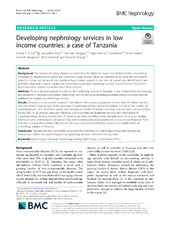| dc.contributor.author | Furia, Francis F. | en_US |
| dc.contributor.author | Shoo, Jacqueline | en_US |
| dc.contributor.author | Ruggajo, Paschal Joseph | en_US |
| dc.contributor.author | Kilonzo, Kajiru | en_US |
| dc.contributor.author | Basu, Gopal | en_US |
| dc.contributor.author | Yeates, Karen | en_US |
| dc.contributor.author | Varughese, Santosh | en_US |
| dc.contributor.author | Svarstad, Einar | en_US |
| dc.contributor.author | Kisanga, Onesmo | en_US |
| dc.date.accessioned | 2020-08-04T08:06:05Z | |
| dc.date.available | 2020-08-04T08:06:05Z | |
| dc.date.issued | 2019-10-17 | |
| dc.Published | Furia, Shoo, Ruggajo PJ, Kilonzo, Basu G, Yeates, Varughese, Svarstad E, Kisanga. Developing nephrology services in low income countries: A case of Tanzania. BMC Nephrology. 2019;20:378 | eng |
| dc.identifier.issn | 1471-2369 | |
| dc.identifier.uri | https://hdl.handle.net/1956/23387 | |
| dc.description.abstract | Background: The burden of kidney diseases is reported to be higher in lower- and middle-income countries as compared to developed countries, and countries in sub-Saharan Africa are reported to be most affected. Health systems in most sub-Sahara African countries have limited capacity in the form of trained and skilled health care providers, diagnostic support, equipment and policies to provide nephrology services. Several initiatives have been implemented to support establishment of these services. Methods: This is a situation analysis to examine the nephrology services in Tanzania. It was conducted by interviewing key personnel in institutions providing nephrology services aiming at describing available services and international collaborators supporting nephrology services. Results: Tanzania is a low-income country in Sub-Saharan Africa with a population of more than 55 million that has seen remarkable improvement in the provision of nephrology services and these include increase in the number of nephrologists to 14 in 2018 from one in 2006, increase in number of dialysis units from one unit (0.03 unit per million) before 2007 to 28 units (0.5 units per million) in 2018 and improved diagnostic services with introduction of nephropathology services. Government of Tanzania has been providing kidney transplantation services by funding referral of donor and recipients abroad and has now introduced local transplantation services in two hospitals. There have been strong international collaborators who have supported nephrology services and establishment of nephrology training in Tanzania. Conclusion: Tanzania has seen remarkable achievement in provision of nephrology services and provides an interesting model to be used in supporting nephrology services in low income countries. | en_US |
| dc.language.iso | eng | eng |
| dc.publisher | BioMed Central | eng |
| dc.rights | Attribution CC BY | eng |
| dc.rights.uri | http://creativecommons.org/licenses/by/4.0/ | eng |
| dc.title | Developing nephrology services in low income countries: A case of Tanzania | en_US |
| dc.type | Peer reviewed | |
| dc.type | Journal article | |
| dc.date.updated | 2020-02-05T18:09:09Z | |
| dc.description.version | publishedVersion | en_US |
| dc.rights.holder | Copyright 2019 The Authors | |
| dc.identifier.doi | https://doi.org/10.1186/s12882-019-1568-7 | |
| dc.identifier.cristin | 1749834 | |
| dc.source.journal | BMC Nephrology | |

